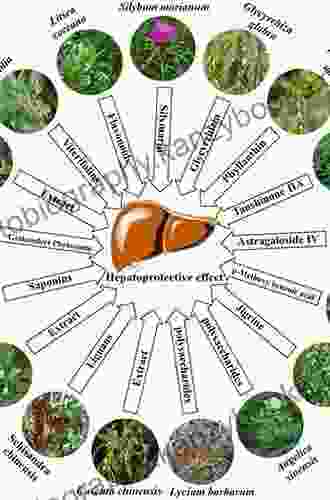An Introduction to the Chemistry and Therapeutics of Herbal Medicine: Unlocking the Healing Power of Nature

Herbal medicine, an ancient practice rooted in traditional knowledge and cultural wisdom, has played a pivotal role in healthcare for centuries. From the healing remedies of ancient Egypt to the medicinal concoctions of Ayurvedic practitioners, plants have been harnessed to treat a wide range of ailments and promote well-being. In recent years, scientific research has shed light on the intricate chemistry and therapeutic potential of medicinal plants, leading to a renewed interest in herbal medicine as a complementary or alternative treatment approach.
4.7 out of 5
| Language | : | English |
| File size | : | 3800 KB |
| Text-to-Speech | : | Enabled |
| Enhanced typesetting | : | Enabled |
| Print length | : | 184 pages |
The Chemistry of Medicinal Plants
The vast diversity of medicinal plants is matched by the complexity of their chemical composition. Plants produce an array of specialized metabolites, known as phytochemicals, which are responsible for their unique therapeutic properties. These phytochemicals can be classified into various groups, including alkaloids, terpenes, flavonoids, and glycosides, each with distinct chemical structures and biological activities.
* Alkaloids, found in plants like belladonna and opium poppy, act as potent neurotransmitters, influencing the functioning of the nervous system. * Terpenes, abundant in plants like rosemary and lavender, exhibit a wide range of activities, including antibacterial, antifungal, and anti-inflammatory properties. * Flavonoids, present in fruits, vegetables, and tea leaves, are known for their antioxidant and anti-inflammatory effects, contributing to overall health and well-being. * Glycosides, found in plants like foxglove and aloe vera, possess diverse properties, ranging from stimulating the heart to promoting wound healing.
The chemical complexity of medicinal plants presents both opportunities and challenges for researchers. While it offers a vast reservoir of potential therapeutic agents, it also necessitates rigorous scientific investigation to identify, extract, and characterize these compounds safely and effectively.
Therapeutic Uses of Herbal Medicine
Herbal medicine encompasses a wide range of therapeutic applications, from treating minor ailments to managing chronic conditions. Traditional herbal systems, such as Ayurveda and Traditional Chinese Medicine, have accumulated vast knowledge about the medicinal properties of plants over centuries. Modern research continues to validate and expand our understanding of these uses.
* Antibacterial and Antifungal Properties: Many medicinal plants, such as garlic, echinacea, and tea tree oil, possess potent antibacterial and antifungal properties, offering natural alternatives for treating infections. * Anti-Inflammatory and Pain-Relieving Effects: Plants like turmeric, ginger, and willow bark exhibit strong anti-inflammatory and pain-relieving effects, providing relief from conditions like arthritis and headaches. * Cardiovascular Benefits: Certain herbs, such as hawthorn and garlic, have shown promise in supporting cardiovascular health, helping to regulate blood pressure and improve circulation. * Digestive Health: Herbal remedies like peppermint, ginger, and chamomile are commonly used to soothe digestive ailments, reducing symptoms like nausea, indigestion, and bloating. * Immune Support: Plants like elderberry, astragalus, and echinacea have been traditionally used to boost the immune system, helping to ward off infections and enhance overall well-being.
Medicinal Properties of Plants
The therapeutic potential of medicinal plants stems from the diverse medicinal properties they possess. These properties are often attributed to specific phytochemicals present in the plants.
* Antioxidant Activity: Many medicinal plants contain potent antioxidants, which combat oxidative stress and protect cells from damage. This antioxidant activity has been linked to reduced risk of chronic diseases like cancer and heart disease. * Antimicrobial Activity: The antibacterial and antifungal properties of medicinal plants make them valuable natural remedies for treating infections, offering an alternative to synthetic antibiotics. * Anti-Inflammatory Properties: Medicinal plants with anti-inflammatory effects can help reduce inflammation throughout the body, alleviating symptoms of chronic conditions like arthritis and asthma. * Immunomodulatory Effects: Certain herbs have the ability to modulate the immune system, enhancing its ability to fight infections and protect against disease. * Neuroprotective Properties: Some medicinal plants exhibit neuroprotective effects, helping to protect the brain from damage and potentially reducing the risk of neurodegenerative diseases.
Evidence-Based Approach to Herbal Medicine
While herbal medicine has a long history of traditional use, it is essential to approach its application with a critical and evidence-based mindset. The scientific validation of herbal remedies is crucial to ensure their safety, efficacy, and appropriate integration into healthcare practices.
* Clinical Trials: Rigorous clinical trials are essential to evaluate the effectiveness and safety of herbal medicines. Controlled studies compare the effects of herbal treatments with standard treatments or placebos. * Pharmacological Studies: In-depth pharmacological studies investigate the mechanisms of action of herbal medicines, identifying the specific phytochemicals responsible for their therapeutic effects. * Safety Assessment: Thorough safety assessments are necessary to identify potential adverse effects, drug interactions, or contraindications associated with herbal medicine use.
Responsible Use of Herbal Medicine
While herbal medicine can offer valuable therapeutic benefits, it is essential to use it responsibly. Here are some key considerations:
* Consult a Healthcare Professional: Before using any herbal medicines, consult with a qualified healthcare professional to discuss potential benefits, risks, and interactions with other medications. * Choose Reputable Sources: Free Download herbal products from reputable sources that provide information about the ingredients, quality control, and manufacturing processes. * Follow Dosage Instructions: Always follow the recommended dosage instructions on herbal medicine labels and do not exceed recommended amounts. * Be Aware of Interactions: Inform your healthcare professional about all herbal medicines you are using, as they may interact with prescription drugs or other dietary supplements. * Monitor for Side Effects: Pay attention to any unexpected or adverse effects when using herbal medicines and discontinue use if necessary.
Herbal medicine, with its rich history and vast array of therapeutic applications, offers a valuable addition to modern healthcare. The chemistry of medicinal plants is exceedingly complex, yielding a diverse range of phytochemicals with unique biological activities. Scientific research continues to validate and expand our understanding of the therapeutic uses and medicinal properties of plants.
By embracing a responsible and evidence-based approach to herbal medicine, we can harness the healing power of nature to complement conventional medical treatments, promote well-being, and support a healthier and more holistic approach to healthcare.
4.7 out of 5
| Language | : | English |
| File size | : | 3800 KB |
| Text-to-Speech | : | Enabled |
| Enhanced typesetting | : | Enabled |
| Print length | : | 184 pages |
Do you want to contribute by writing guest posts on this blog?
Please contact us and send us a resume of previous articles that you have written.
 Book
Book Novel
Novel Page
Page Chapter
Chapter Text
Text Story
Story Genre
Genre Reader
Reader Library
Library Paperback
Paperback E-book
E-book Magazine
Magazine Newspaper
Newspaper Paragraph
Paragraph Sentence
Sentence Bookmark
Bookmark Shelf
Shelf Glossary
Glossary Bibliography
Bibliography Foreword
Foreword Preface
Preface Synopsis
Synopsis Annotation
Annotation Footnote
Footnote Manuscript
Manuscript Scroll
Scroll Codex
Codex Tome
Tome Bestseller
Bestseller Classics
Classics Library card
Library card Narrative
Narrative Biography
Biography Autobiography
Autobiography Memoir
Memoir Reference
Reference Encyclopedia
Encyclopedia Steve Edwards
Steve Edwards Angela Agranoff
Angela Agranoff Pete Sulack
Pete Sulack Robert D Lesslie
Robert D Lesslie Andrey Albitov
Andrey Albitov Andrew Mcwade
Andrew Mcwade Mark Lees
Mark Lees Andrea Slonecker
Andrea Slonecker Gordon Faulkner
Gordon Faulkner Anna Smithers
Anna Smithers Andrew M Greeley
Andrew M Greeley Vincent T L
Vincent T L Carmela Lavigna Coyle
Carmela Lavigna Coyle Lydia Bosson
Lydia Bosson Andrew Whitechapel
Andrew Whitechapel Angela Diterlizzi
Angela Diterlizzi Andrew Mioch
Andrew Mioch Alison Wray
Alison Wray Andrew Mason
Andrew Mason Andrew Hitchings
Andrew Hitchings
Light bulbAdvertise smarter! Our strategic ad space ensures maximum exposure. Reserve your spot today!

 Terence NelsonGluten Free Cookies Recipe: The Ultimate Cookbook For Delicious And Tasty...
Terence NelsonGluten Free Cookies Recipe: The Ultimate Cookbook For Delicious And Tasty... Brennan BlairFollow ·2.2k
Brennan BlairFollow ·2.2k Branden SimmonsFollow ·12.6k
Branden SimmonsFollow ·12.6k Richard SimmonsFollow ·16.2k
Richard SimmonsFollow ·16.2k Geoffrey BlairFollow ·2.7k
Geoffrey BlairFollow ·2.7k Thomas HardyFollow ·7.3k
Thomas HardyFollow ·7.3k Craig BlairFollow ·6.7k
Craig BlairFollow ·6.7k Nick TurnerFollow ·7.3k
Nick TurnerFollow ·7.3k Vince HayesFollow ·17.8k
Vince HayesFollow ·17.8k

 Emilio Cox
Emilio CoxAncient Wisdom for Your Healthy, Happy, and Beautiful...
In our fast-paced modern world, it can be...

 Justin Bell
Justin BellThe Bully Tales From The Sheep Pen: A Must-Read for...
Bullying is a...

 Duane Kelly
Duane KellyWhat Cancer Taught Me About Living And Dying: A Journey...
In "What Cancer Taught Me About Living...

 David Peterson
David PetersonMy Wee Granny's Soups and Stews: A Culinary Tapestry of...
Are you longing for the...

 Lee Simmons
Lee SimmonsEmbark on a Culinary Adventure with "Deviled Eggs: 50...
: Unlocking the Delectable World of...
4.7 out of 5
| Language | : | English |
| File size | : | 3800 KB |
| Text-to-Speech | : | Enabled |
| Enhanced typesetting | : | Enabled |
| Print length | : | 184 pages |












